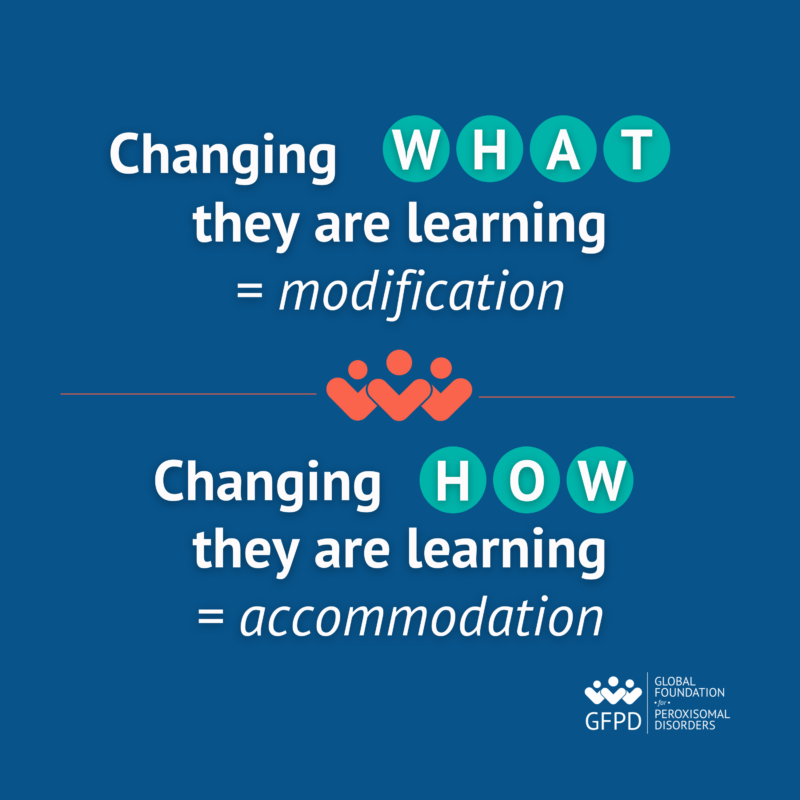As summer draws to a close in the US, families across the country are preparing for the return to school. For families with children who have peroxisomal disorders, this time of year can bring unique challenges and concerns. At the Global Foundation for Peroxisomal Disorders (GFPD), we understand the complexities that these families face and are here to provide guidance with this back to school series and support as you navigate the new school year.
As we continue this blog series, we’ve already explored the Pyramid of Learning for deafblind learners, and we will discuss special modifications and accommodations for children with deafblindness, share recommended techniques to be used with deafblind learners, emphasize the importance of Individualized Education Programs (IEPs), and more.
Part Two:
Modifications and Accommodations
Children with disabilities encounter many barriers within society, especially in the field of education. For GFPD Warriors who have deafblindness, the challenges may include barriers to accessing their education, environment, and communication. Two ways of assisting students with disabilities include providing appropriate modifications and accommodations.

Modifications and Accommodations both support student learning, but what is the difference between them?
Modifications change WHAT the child is being taught or expected to learn.
Modifications are specifically designed for students that are not expected to learn or produce work at the same level as their peers. Therefore, the goals and expectations for these students change because of the need for adjusted assignments and/or levels of difficulty. It is crucial to recognize that although modifications tailor the curriculum to meet the student’s individual needs, maintaining high expectations should still occur, to foster the student’s opportunities for progress, growth, and success.
Examples of Modifications
- Modified workload or length of assignments / tests
- Adjusting support levels provided during independent activities
- Modified functional curriculum in all core areas, tailored to meet students’ needs
Accommodations change HOW a child learns the same material as their peers.
This may encompass both how the student is taught or how the student is assessed, yet it does not alter the actual content being learned. The accommodations in place dictate HOW the student can learn the same information being presented. Accommodations are meant to level the playing field, allowing the student to achieve success learning the same content as their peers, without the obstacles presented by their disabilities.
Examples of Accommodations
- Frequent breaks throughout the day
- Providing a tutor and / or a notetaker
- Braille, hands on materials, tactile graphics, etc.
- Utilizing Assistive Technology Equipment (e.g., audio amplification devices, assistive learning devices, etc.)
- Slant board
- Preferential seating
- Extended time (e.g., time on assignments or testing, visually locating people or materials, processing, responding, etc.)
- High illumination with reduced glare
- Simple, clutter-free, and high-contrast materials
- Adaptive and tactile signing
- Hand-Under-Hand instruction
The above examples present a concise overview, and may require further clarification within an Individualized Educations Plan (IEP) to ensure a clear understanding of the requirements and the context in which they apply.
For instance, the previously mentioned “High illumination with reduced glare” can be elaborated upon by detailing the implementation of overhead fabric light shades to diminish glare while still ensuring high illumination in the learning environment. Positioning can be a critical accommodation to enhance optimal learning, and clarity may be improved by specifying whether it pertains to the child’s actual positioning, what that positioning entails, and / or positioning of the materials.
Watch Clair Turbeville, a Teacher of the Visually Impaired (TVI), discuss and share examples here.
Ways to Identify, Determine, and Plan for Modifications and Accommodations
- Request a meeting with the IEP and / or education team members
- Read the students’ IEPs and 504 plans to understand required supports
- Collaborate with team members (e.g., parents, teachers, related service providers, etc.) to identify learning barriers
- Discuss with the team if modifications or accommodations are needed for certain areas of the students’ education, across the board, or a mixture of both
- Determine if any equipment needs a new or specifically designated space for use and / or storage when not in use
- Identify the best way to track and monitor how the modifications and / or accommodations are working for the student
- Consider when you should revisit the newly implemented modifications and / or accommodations to share data collected and determine any needed adjustments
Things to Remember
- Vision and hearing loss differ among individuals with deafblindness; therefore, the accommodations needed for deafblind students are varied and must be tailored to each individual
- Deafblindness can significantly impact communication, mobility, and learning
- Students may face varying barriers in different learning environments, necessitating varied accommodations for each setting
- Collaboration is key to creating an inclusive and supportive learning environment for children with deafblindness
- Maintaining high expectations should still occur to foster the student’s opportunities for progress, growth and success
Modifications and accommodations are two of several critical components of the Individual Education Plan (IEP). Stay tuned for our next blog post in this educational series to learn more about the IEP process.
You can also check out the previous blog for this series, PYRAMID OF LEARNING, to learn about the significant differences between typical learning and deafblind learning.
Written By Katie Sacra
Sources: Wrightslaw and Understood
